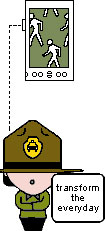| |
 |
|
||||||||
|
|
| "All spectators must also be performers. Such dissolution of the boundaries of separation is covalent with a culture that flowers in the corporeal, nonregulated, and noncommodified..." -Graham St. John on Hakim Bey's "Temporary Autonomous Zone" Translocation describes a way of creating global connections through an emphatic articulation of the local or many locals, which can be quirky, fractured and sometimes fractious. PDPal, our project for the PDA and web, experiments with both hybrid and new expressions of space/place and individual/communities in a highly mobile - and motile - form . PDPal operates on three interwoven trajectories which , when experienced together, approach the idea of a "communicity: " a made-up city of individuals who share a subjective and poetic language with which to express their local(es) in ways that can render visible the invisible. 1. Plotting: my own city. The first layer is mobile. The user's everyday journeys in her city are mapped on her PDA: No matter where you are, you carry your own city within you. PDPal is a PDA-based notational application that allows you to map your passages in an unconventional form. Not reliant upon the dominant space/time signatures (date + time, x/y plotting, landmarks), PDPal instead provides the tools to create maps as place-based memory shells or to stand in as a narrative shorthand- marking personal intervals of place and experience. PDPal allows a user to reconsider and playfully retool her concepts of the city. A city can be real, or imagined, and usually has overlays of both. PDPal allows a user's distinct city or cities to emerge through an algorhythmic interpretation of abstracted urban criteria: The textural, the social, the environmental, and the temporal. PDPal's maps can be to "place" what words are to objects: slippery, mutable and highly interpretive signifiers. PDPal establishes what we call Temporary Personal Urbanisms (playing on the notion of Hakim Bey's Temporary Autonomous Zones) that can un-fix the hegemonic, binary breakdowns of time and place. 2. Communing: the "communicity." The secondary layer of experience links users to each other via a web presence- a visual "BLOG"- that will display the matrix of user-created maps and allow access to each person's recorded intervals. There will be opportunity in the BLOG for users to append their maps with text modules specific to the map made at that moment. The "communicity" of PDPal is anti-GPS; while displacing the specific and bounded, it creates bridges between the tangible and the unbounded. This new urbanscape is composed of tourists, locals and hybrids; there is free exchange between each role's identity and desire. 3. Receiving: urban adventures. Once a user engages with PDPal, she will receive a series of guides and maps. This third layer of reception is made of invisible-made-visible layers and provocations that are sent back to the user in two forms: A. Maps- these range from specific urban scapes made up of networks and cells, to the hidden urban adventures and surveilled routes, to the palimpsestic and taboo histories of place B. Guides- generic instructions that recall Fluxus' Fluxtours, Erwin Wurm, Janet Cardiff, and John Cage; PDPal's guides also stem from the concepts of the Temporary Autonomous Zone that Hakim Bey describes These trajectories summarily explore a new form of city: one made of individual nodes through poetic map-making while slipping back and forth between the global and the local, the specific and generic, the physical and the virtual. There are many depths of interaction possible with PDPal that will catalyze "writeable cities;" we hope to re-activate a sense of urban adventure and draw new relationships between the "real," the "invisible," and the "virtual." |